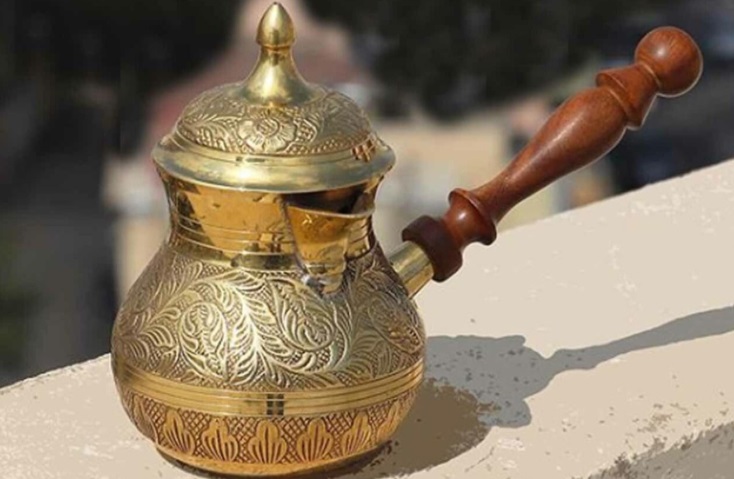
Antique Turkish coffee pots, known as ‘cezve’ or ‘ibrik,’ hold a special place in the rich tapestry of coffee culture. Originating from the Ottoman Empire, these pots are not just tools for brewing coffee; they are symbols of hospitality and deep-rooted tradition. For centuries, preparing coffee in these pots has been considered an art, intricately tied to social rituals and ceremonies. The method of brewing in a cezve—over low heat, with water and finely ground coffee beans—creates a distinctive flavor and texture, celebrated across generations.
Description of Common Materials and Craftsmanship
The allure of antique Turkish coffee pots lies in their variety and the craftsmanship behind each piece. Predominantly made from copper, renowned for its excellent heat conductivity, these pots are designed to brew the perfect cup of Turkish coffee. Copper pots often feature tin linings to prevent corrosion, ensuring longevity and safety in brewing. Brass and silver are also common, each adding a unique aesthetic and functional quality to the pots.
Artisans historically hand-hammered intricate designs into the metal, making each pot a work of art. Handles, typically made from wood or brass, are designed not only for functionality but also to add to the pot’s ornate beauty.
Key Takeaways
- Importance of Material in Heat Conductivity and Durability: Copper stands out as the star material for antique Turkish coffee pots, cherished for its superior heat conductivity. This feature ensures an evenly brewed coffee, embodying rich flavors and aromas. Beyond functionality, copper’s luster and patina add an undeniable aesthetic appeal. Its durability, when cared for properly, allows these pots to become cherished heirlooms, passed down through generations.
- Variety in Design Reflecting Historical and Regional Influences: Each antique Turkish coffee pot tells a story, its design a testament to the era and region from which it hails. Hand-hammered patterns and ornate details speak of the artisan’s skill and the cultural significance of coffee in Turkish society. From the simplest to the most elaborate designs, these pots serve as a bridge to the past, showcasing the rich history and diversity of Turkish craftsmanship.
- Practical Considerations Such as Size, Handle Material, and Maintenance: When it comes to antique Turkish coffee pots, practicality is as important as aesthetics. The size of the pot should match your brewing needs, affecting the coffee’s strength and quality. The handle material, often wood or metal, influences handling and durability. Maintenance is straightforward but crucial; proper care ensures these pots continue to brew delightful coffee while retaining their beauty.
- Cultural and Collectible Value: Beyond their practical use, antique Turkish coffee pots hold immense cultural and collectible value. They are not merely tools for brewing coffee but symbols of a centuries-old tradition that elevates coffee drinking to a ritualistic art. For collectors and enthusiasts, these pots are treasures, each unique piece a fragment of history and a testament to the enduring appeal of Turkish coffee culture.
Historical Context and Cultural Significance
Turkish coffee’s journey begins in the 15th century, finding its roots in the Ottoman Empire. It’s more than a drink; it’s a cultural artifact, representing hospitality, friendship, and tradition. The coffee pot, or ‘cezve,’ is central to this tradition. Designed for the unique preparation method that involves simmering water, finely ground coffee, and sometimes sugar, the cezve’s shape—a wide bottom and narrow top—facilitates the perfect brew.
This method creates the coffee’s signature foam, a hallmark of a well-made cup. The ritual of preparing and serving Turkish coffee in a cezve is an intangible heritage, passed down through generations, embodying the spirit of togetherness and the art of living.
The Evolution of Design and Materials Over the Centuries
Initially, Turkish coffee pots were simple, focusing more on functionality. As coffee culture flourished, so did the designs and materials of the cezve. From the basic brass and copper pots of the early days, artisans began to introduce more elaborate designs, incorporating silver and gold for the elite. The 17th century saw the rise of ornate embellishments, with coffee pots featuring intricate engravings, inlaid jewels, and even calligraphy, reflecting the owner’s status and the artistic trends of the time.
The 19th century introduced mass production, but the handmade, artisanal cezves continued to be prized for their beauty and craftsmanship. Today, antique Turkish coffee pots are revered not just for their utility but as artifacts of a rich, coffee-imbued history, each bearing the marks of its time and the hands that crafted it. These pots are a testament to the enduring legacy of Turkish coffee culture, evolving yet timeless.
Selecting an Antique Turkish Coffee Pot
When hunting for an antique Turkish coffee pot, the thrill lies in finding a piece that speaks of history, craftsmanship, and tradition. Here are some essentials to guide your search:
- Material: Copper is classic, revered for its heat conductivity and traditional appeal. Brass and silver variants offer their own charms, each impacting the coffee’s taste and the pot’s durability differently.
- Craftsmanship: Look for signs of handcrafting—hammered textures, intricate designs, and the smoothness of the pot’s interior. These details not only contribute to the pot’s beauty but also its authenticity.
- Condition: While wear is expected, assess for any repairs or damages that might affect the pot’s use or value. A well-preserved patina adds character, telling stories of past brews.
- Authenticity: True antique pots carry the weight of history. They often come with markers of their origin—maker’s marks, hallmarks, or even inscriptions—testifying to their journey through time.
Tips for Identifying Genuine Antique Pieces
Distinguishing genuine antiques from replicas requires a keen eye and some know-how:
- Research: Familiarize yourself with the styles and markers of different periods. Knowing what to expect in terms of design and material can help you spot anomalies.
- Marks and Signatures: Genuine pieces often bear the maker’s mark, a hallmark, or signatures that can be traced back to a specific era or craftsman.
- Wear and Patina: Authentic antiques display a natural patina and wear patterns consistent with age. Uniform aging and appropriate signs of use are good indicators.
- Ask Questions: Don’t hesitate to ask sellers about the pot’s history, provenance, and any restoration work done. Reputable dealers will be transparent, providing additional assurance of authenticity.
Cleaning and Preserving Antique Coffee Pots
Keeping your antique Turkish coffee pot in tip-top shape is all about gentle care. Start by hand-washing it with a soft sponge and mild detergent; abrasive materials can scratch the metal surface. Avoid dishwasher use, as the harsh chemicals and high heat can damage the pot’s patina and material.
For copper pots, lemon and salt can work wonders in restoring the shine, but use this method sparingly to preserve the antique look. After cleaning, thoroughly dry the pot to prevent tarnish, especially if it’s made of copper or brass. Regular, gentle cleaning maintains both the functionality and aesthetic of your antique treasure.
Repair and Restoration Advice for Damaged or Worn Items
For pots showing signs of wear or damage, consider professional restoration. Minor dents can often be gently smoothed out, but significant damage may require the expertise of a metalwork specialist to preserve the pot’s integrity and appearance. If the interior tin lining of a copper pot wears thin, it’s crucial to have it re-tinned to ensure safe use for coffee brewing.
Always consult with experts who specialize in antique metals; they can provide guidance on preserving your pot’s historical value while making it functional for your morning brew. Remember, the goal of restoration is to maintain the pot’s character, not to make it look brand new.
FAQs
Why are Turkish coffee pots made of copper?
Copper is the go-to material for Turkish coffee pots because of its superior heat conductivity. This feature allows for quick and even heating, crucial for brewing the perfect cup of Turkish coffee. Plus, copper’s traditional charm adds to the aesthetic appeal.
How to choose the right size for a Turkish coffee pot?
Choosing the right size depends on how much coffee you usually make. Turkish coffee pots come in various sizes, typically measured by the number of cups they can brew. For personal use, a small pot may suffice, while entertaining guests might require a larger one.
Can antique coffee pots be used for daily coffee preparation?
Yes, antique coffee pots can be used daily, provided they’re in good condition and properly maintained. Ensure the pot is cleaned gently after each use and checked regularly for any signs of wear or damage that could affect its usability.
Are there any health concerns associated with using antique copper coffee pots?
When using antique copper coffee pots, ensure they are lined with tin or another non-reactive metal. Unlined copper can react with acidic foods or drinks, potentially leading to copper leaching into your coffee. Regular re-tinning of the interior is recommended for safety.
Final Thoughts
The allure of the antique Turkish coffee pot lies not just in its utility but in its embodiment of a centuries-old tradition. These pots are more than just kitchenware; they are pieces of art, steeped in history and culture. Whether it’s the unparalleled heat conductivity of copper, the intricacy of hand-hammered designs, or the pot’s role in the ceremonial preparation of coffee, each aspect contributes to its enduring appeal.








